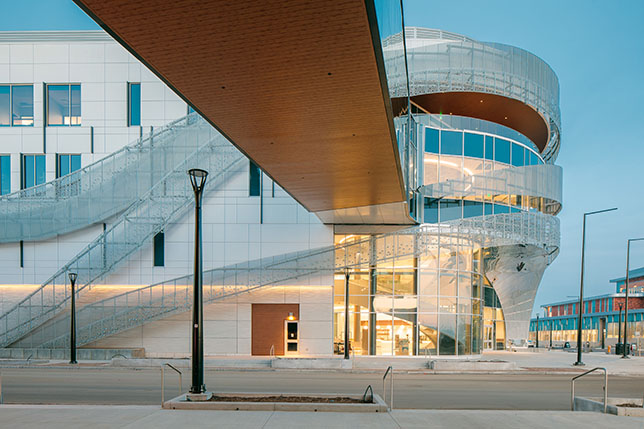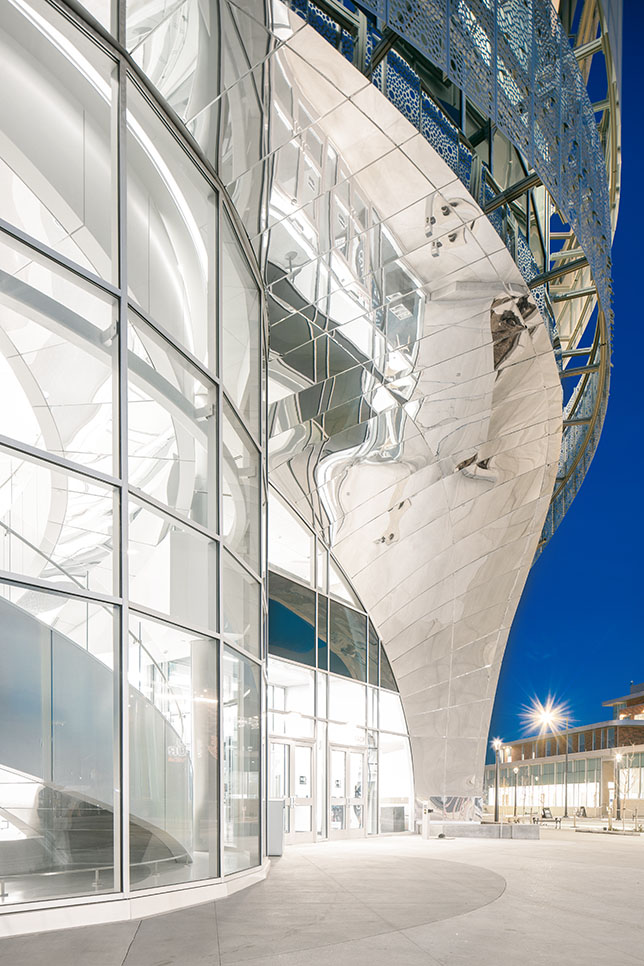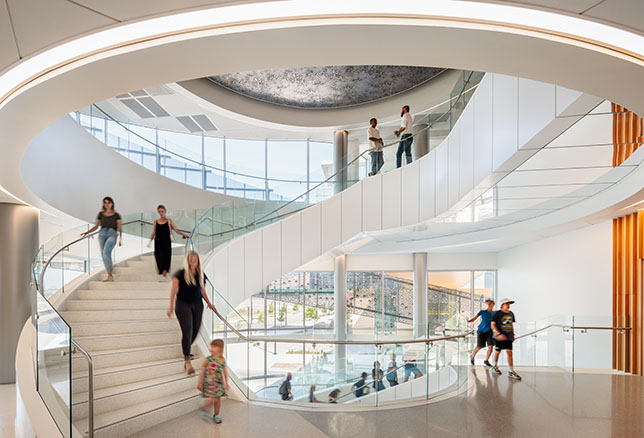The HYDRO Building: Where Water Conservation Meets Preservation
By Jennifer Cordes, AIA, LEED AP BD+C
Sustainability stands as a beacon guiding modern architecture, where structures not only serve functional purposes but also contribute positively to the environment and community. The pursuit towards achieving a net-zero campus has gained considerable traction within institutions of higher education. More than 330 universities and colleges in the U.S. have pledged to achieve carbon neutrality by 2050. At the forefront of the movement is the need for clean water. Rooted in the impact of Colorado’s water footprint on millions of people in multiple states and Mexico, Colorado State University’s (CSU) Hydro Building is designed to offer a unique user experience that teaches visitors about water conservation through public art installations, various educational exhibits and views into professional active scientific research laboratories.
In hopes of revitalizing the 200-year-old Colorado National Western Center, the Hydro building is a transformative, civic-centered, living laboratory that connects the urban core of Denver to the rural communities across the region through water literacy and conservation. As one of three signature buildings on the CSU Spur campus, Hydro reflects the water-focused research, education, and policy-making inside. Like a flowing river, Hydro incorporates systems that holistically integrate the building with the goal of creating a net-zero-energy campus that utilizes a waste-water heat recovery system to energize a revitalized, 360-day-per-year venue at the National Western Center.

Images courtesy of David Lauer Photography
Navigating the Currents of Conservation
The global average water footprint of a consumer is 3.8 tons per day. America has the highest per foot capita footprint of 6.8 tons per day and uses more water per person than almost anywhere else in the world. Ironically, the highest domestic water use is in the driest Western states, all fed from the Colorado River. Due to the National Western Stock Show receiving over 700,000 people per year from 40 states and 30 countries, Hydro has the ability to influence water literacy globally. Located in the Innovation Center of the National Western Center, the 154,000-square-foot building was influenced by the history of the National Western Center site, the Carbon Neutral mission of the Spur campus, and the unique importance of water in the western United States.
Inspired by the cross-section of a river eddy, the 3-story spiral stair and 2-tone perforated metal building scrim flow from the ground through the design, defining entries, framing views, and enfolding the historic McConnell Welders building into the complex on the south end of the site. Like an eddy in the river, the design concept creates moments in the building where visitors can slow down, move against the flow, and learn about the importance of water through hands-on exhibits and physical connection to the outdoors. The river eddy concept inspired the building's location and shape to maximize outdoor open space and its porous relationship to it.
The building’s facade utilizes a sophisticated material palette that capitalizes on textures to create a play of light and shadow on the building. The flowing water-inspired scrim consists of two perforated metal materials supported by the building's floor structure with a light structural framing. The exterior material along the base of the building is a textural concrete panel that has a flowing pattern that runs parallel to the ground. The upper levels are a neutral-colored metal panel with gray and blue glass. Ensuring transparency both into and out of the building careful consideration was given to framing views that showcase the Grand Plaza and the backyard.

The backyard design showcases gray water reuse, innovative stormwater opportunities, research regarding rainwater reuse, and photovoltaic impacts on vegetation –– exemplifying the mission of One Water. One Water is the concept that emphasizes how our planet has a finite amount of water, and it is an essential resource that needs to be efficiently used and reused whenever possible. The landscaping highlights Colorado as a Headwater State and each of its eight watersheds.
LEED certification serves as a tangible demonstration of a higher education institution's commitment to environmental stewardship. The focus on these certifications represents a paradigm shift in how campuses conceive, design, and operate their built environments. Hydro is currently targeting LEED Platinum certification and is achieving a significant reduction in water usage compared to a standard building under the current building code. This reduction is being achieved through the use of efficient fixtures such as low-flow urinals and water closets and a highly energy-efficient mechanical system that saves 22% more electricity and 35% less water than an equivalent building of the same size and complexity.
Approximately 7,500 square feet of green space was included on the roof level to support CSU research on water reuse and vegetation. Green roofs are also a creative stormwater management solution and delay the discharge of rainwater to the sewage system, filter particulate matter from the air and convert CO2 into oxygen through plants. They also contribute to air purification, reduce the ambient temperature, create a cooler and more pleasant climate, and promote the habitat of birds, butterflies and insects.

Navigating the Rapids of Change and Resources
Choosing the right building materials is paramount for sustainability in construction, as it directly impacts the environmental footprint, energy efficiency, and long-term viability of a building. Prioritizing materials with high durability and longevity contributes to the resilience of the building, reducing the need for frequent replacements and minimizing waste generation. By choosing materials that require minimal maintenance and can be easily repaired or replaced, the building's operational efficiency is optimized, reducing the consumption of energy, water, and other resources over time. This aligns with the principle of "reduce, reuse, recycle," by extending the lifespan of building materials and reducing the demand for new resources.
With a keen focus on long-term sustainability, the materials and elements of Hydro have been chosen to minimize environmental impact, while the emphasis on easy maintenance and component replacement ensures uninterrupted functionality. This facility's integration with the campus promotes synergy among different structures and reduces the environmental footprint of the entire complex.

The design of the CSU Hydro building embodies the concept of "Design for Change" through its approach to historic preservation. By integrating the historic McConnell Welders Building into the new structure, the design not only pays homage to the history and unique aspects of Colorado but also symbolizes a dedication to innovation in water research and public education. The materials, form, and environmentally-conscious design elements draw inspiration from the natural environment, particularly the waters of the west, reflecting a forward-thinking approach to change and progress while respecting the past.
Through responsible design and the integration of green principles into their academic programs, operations and institutional culture, universities like CSU can play a crucial role in educating the public on the complex environmental challenges of the 21st century and contribute to building a more sustainable future.
Jennifer Cordes, AIA, LEED AP BD+C is a Principal of Hord Coplan Macht.